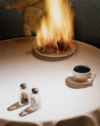A couple of biscuits with cream and a cherry on top, resting on pink plush. One could say that it’s one of these food shots that were sugar-coated far too much. And one would be, to some extent, right, if not for the fact, that the author behind this image is an intriguing American artist – Jo Ann Callis.
There are surely much more peaceful decades to be found in the history of the United States than the 70’. In a time when anti-war protests march through the entire country and discriminated groups, women among them, fight for their rights, Jo Ann Callis is thirty, with two kids and she’s fighting an everyday battle of her own. The stakes are art and the possibility of creating it.
Jo Ann (born in 1940) grows up thinking that art is the path she’s ought to take. She begins university at Columbus, Ohio, but she drops out in 1961 and moves to California with her family. During her first years in Los Angeles, she takes care of the household by day and takes sculpting classes at night. She also makes collages. A breakthrough comes in 1970 when, surprising even herself, she falls in love with photography. Her teacher and mentor, a well-known conceptual artist, Robert Heinecken, encourages his student to let go of inhibitions and reach as far as for the boldest of ideas, which are hiding in the depths of her heart and mind.
Fifty years later, the American has dozens of exhibitions to her account, along with a fulfilling career of photographer and an educator. There is no point in making art unless you do what you want to do, she says. In photography, Callis experiments with different techniques, but the one that stays with her the longest is colour. She can think of herself as lucky – only moments before her times did photographers like William Eggleston i Paul Outerbridge (the latter of whom she believed to be her inspiration) pave the way for in-colour photography. Direct documentation of reality lays besides the boundaries of her interests. Instead, the American becomes a creator of worlds, working from her garage-studio. She builds her sets using homeware, fabrics, self-made sculptures and objects. She works with androgynous models; she purposely hides their faces. At the beginning of 90’, she works on an important series titled ‘Cheap Thrills‘ – a collection of photographs of stylised desserts.
The strength of the nudes, still natures and other works of the artist is dependent on their sensuality, tension, the infatuating, yet unnerving surrealism. Callis does not identify with any group, she doesn’t want to be called a feminist, nor to tell any ‘Great’, universal stories. Her photography was meant for her, and only her – as stated by the artist – they talk about the suffocating, claustrophobic reality, which she’s experienced, and about her own fears and uncertainties. And yet, a couple of decades after they came to be, they still speak to us in volumes.









